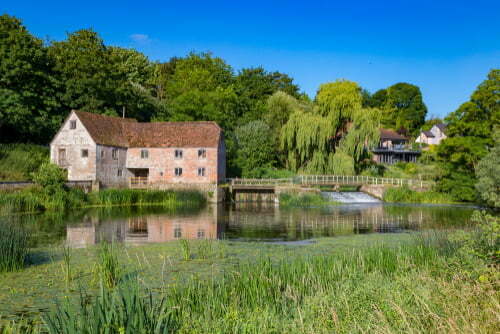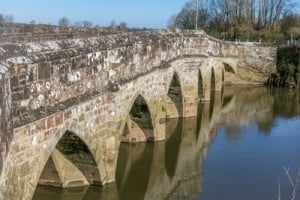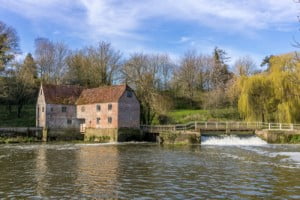
Sturminster Newton in Brief
Sturminster Newton is a town and civil parish in the Blackmore Vale area of Dorset, southwest England. The town is situated some 17 miles (27 km) east of Yeovil, and 8 miles (13 km) southwest of Shaftsbury. The majority of the town (Sturminster) is located at a fording point on the north bank of the River Stour. The town is also a hub for the wider area’s large dairy farming industry on which the local economy is largely built. Sturminster is also known for once being the residence of famed 19th-century author Thomas Hardy. In 2019, the population of the town was estimated at 3,646.
A Fleeting History
Early Times
There is evidence to suggest that the Sturminster Newton area was settled millennia. However, there’s relatively little known of the town’s history through the Medieval Period. One thing that is known is that in AD 968 ‘Nywetone at Stoure’ was granted to Glastonbury Abbey by the Saxon king Edgar. By 1086, the town was known as ‘Newentone’ as it was recorded in the Domesday Book.
Originally, the name Sturminster Newton referred to two separate settlements. They were located on either side of the River Stour. ‘Newton’ was derived from Old English for a new settlement, while ‘Sturminster’ translated as a “church (minster) on the Stour”. The names were eventually combined to distinguish the town from nearby Sturminster Marshall and other local Newtons.
A Medieval Boom Town
In 1219, Henry III granted Sturminster the right to hold an annual fair. Around a century later, the Abbot of Glastonbury was also bestowed the right to hold a weekly market and an annual 3-day fair in the town. Also in the 14th century, a manor house, now known as Sturminster Newton Castle, was built. The house was constructed on a mound that is thought to have been the site of an Iron Age hill fort. Another major development in the 14th century was the building of the local parish church St Mary’s. In 1486, the church was completely rebuilt at the request of the Abbot of Glastonbury.
By the late Medieval period, Sturminster was booming and had become a local hub for craft industries. It was particularly known for the production of cloth and leather. It’s recorded that the town began to hold weekly livestock markets in 1496. It was around this time that a market cross was erected in the town centre. Around 1500, a six-arch stone bridge was built to replace the ford crossing of the Stour. At the same time Market Cross House was also built, a sure sign of the town’s growing prosperity.

Sturminster’s six-arch bridge was built around 1500.
Dissolution and Civil War
Henry VIII’s Dissolution of the Monasteries Act saw Glastonbury Abbey dissolved in 1539. Its estates, including those at Sturminster, reverted to the crown. In 1544, Henry VIII granted the manor of Newton to Katherine Parr. She undertook the task of having the 14th-century manor house at Sturminster Castle completely renovated.
In 1644, during the English Civil War, the royalist town was taken by parliamentary forces without a fight. In 1645, a group of Dorset Clubmen (a local militia) attacked the town’s Roundhead garrison. Apart from the low-key encounter, the civil war largely passed Sturminster without incident. However, the town did see disaster in 1681, when a major fire struck. An even bigger fire occurred in 1729, which saw a large portion of the town razed to the ground.
The Industrial Revolution
In the post-medieval period, Sturminster’s main industry was cloth-making. The town was particularly renowned for the production of swanskin. The coarse white woollen cloth was mainly used for producing military uniforms and fishermen’s clothing. By 1793, it is estimated that around 1200 of the town’s population were employed in the industry. The town was also producing leather, buttons, gloves, and clocks at the same time. However, during the 19th century, Sturminster’s cloth industry went into a steep decline. A slump from which it would never recover.
On 31 August 1863, Sturminster Newton railway station opened on the new Somerset and Dorset Joint Railway (S&DJR). The single-track line stretched 65 miles from Bath to Bournemouth. The arrival of the railway was a major boost for the town, especially its agricultural industry. Over the 19th century, the Blackmore Vale area saw a shift away from sheep farming towards dairy. In 1906, the local cattle market moved to a new one-acre site. By the mid-20th century, the now 7-acre market had become the largest in Europe.
Another development in 1906 saw mains water arrive in Sturminster. In 1913, a creamery was set up by local farmers to produce cheese and pasteurised milk. The railway afforded good transport links to the factory, helping in its success. In 1924, the town got its first electricity supply, with a connection to the national grid 8 years later.
The Modern Era
In 1937, the town’s creamery was taken over by the Milk Marketing Board. The ‘milk’ trains ran until March 1966, when the railway fell foul of the Beeching Axe. The station and goods yard were demolished in the mid-1970s. However, the creamery remained in operation until 2000. It was then shut down by the owners Dairy Crest who moved production elsewhere. Similarly, in 1997, the town’s renowned cattle market was closed and demolished soon after.
Today, the town’s economy is well balanced, being made up of retail, the service sector, local manufacture and logistics, and hospitality. Agriculture is also still important to the area.
A carnival is held each year during August. It includes a children’s parade, carnival floats, bands, and a fancy dress parade, in addition to various other events during the carnival week. The town is also in a convenient location for the Great Dorset Steam Fair at Tarrant Hinton, held in early September each year. This is one of the world’s biggest steam fairs with thousands of exhibits and attractions, including a large funfair. Another event in early September is a must for “foodies”. This is the Sturminster Newton Cheese Festival, which is by no means confined just to cheese.
Sturminster Newton is twinned with Montebourg in Normandy, France
Getting to Sturminster Newton
Sturminster Newton is situated on the A357 which runs northwards between Blandford Forum and Wincanton. Thus, the majority of drivers will find either the M5/A372/A303 or the M3/A303 the best route to get there. Both will bring you to Wincanton where you turn off the A303 for the A357.
The nearest train station to Sturminster Newton is Templecombe, some 10 miles away. South West trains operate an hourly service from London Waterloo to Templecombe. The rail journey usually takes around 2 hours 15 mins. There’s a regular service bus from Templecombe to Sturminster which takes about an hour.
The nearest airports to Sturminster Newton are Bournemouth (BOH) 27 miles away, and Bristol (BRS) 47 miles away.
A Notable Resident
Famed 19th-century author Thomas Hardy moved to Sturminster Newton in 1876. He lived in the town with his new wife Emma Gifford for almost 2 years. He wrote his sixth published novel ‘The Return of the Native’, whilst living in the town. Later, Hardy described life in the town as “idyllic” and among the happiest of his life.
Did you Know?
Sturminster Newton was 19th-century author Thomas Hardy’s inspiration behind the fictional town of Stourbridge. The town featured in one of his best-loved novels ‘Tess of the d’Urbervilles’.
Things to see and do!
Sturminster Newton Museum
The small museum is housed in a striking 16th-century building situated right in the town centre. Its permanent displays cover aspects of the town’s history. These include the rise and fall of the cattle market, the history of the creamery, and the town’s connections with famed literary figures such as Thomas Hardy and William Barnes.
Sturminster Mill
The ancient Sturminster Mill is located on the southern edge of the town. It’s thought there’s been a working mill on the site since Saxon times. The mill ran by a local charity still produces flour. It’s open to the public on Mon, Thurs, Sat & Sun from 11 am until 5 pm. The modest entrance fee includes a guided tour. There’s also free parking and a gift shop & cafe.

Sturminster Mill is thought to date to the early 11th century
Fiddleford Manor
The 14th-century Fiddleford Manor is located about 2 miles south of Sturminster. It’s thought the house was originally built for William Latimer, the Sheriff of Dorset & Somerset. The manor is owned by the National Trust and is free to enter. Its open daily, 10 am – 6 pm from April to October, and 10 am – 4 pm from November to March.
Shoot some Clay
The AA Shooting School is about 4 miles north of Sturminster. Novices can learn to shoot clay pigeons in a safe environment taught by experienced instructors in a one-to-one situation. Families and other groups are also welcome.
Take a Stroll
There are lots of picturesque circular walks around Sturminster ranging from around 2 miles to 6 miles. A number of the recognised walks start at Station Road Car Park. All the walks pass ancient buildings and/or landmarks. If your luck is in, you’ll also be able to observe a variety of wildlife on most of the walks.
Play it Cool
CoolPlay is an indoor playground, games, and entertainment centre located in the town. The centre is suitable for both children and adults. It’s open Tuesday to Sunday (and Bank Holiday Mondays) from 10 am – 4 pm. The hot & cold food is available throughout most of the day.
Where to stay?
Sturminster Newton and the immediate surrounding area offer a good range of accommodation choices. Hotels, guesthouses, B&Bs, inns, self-catering cottages, and farm stays are all available within a few miles of the town. Shaftesbury and Sherborne, both 7-8 miles away, are an alternative to staying in Sturminster.
Moving to Sturminster Newton?
Properties in Sturminster Newton sold for an average price of approximately £366,000 over the last year (Sep 2021). The best-selling houses were detached properties, which sold for an average price of around £446,000. Flats sold for an average price of £118,500, terraced properties for £226,000, and semi-detached properties fetched £289,000. Overall, the average sold property price in Sturminster Newton over the last year was 16% up on the previous year.
Thinking of a Staycation?
Are you thinking of holidaying in the UK sometime soon? If so, why not check out some of our other travel guides for some staycation ideas? I think you’ll be surprised at the variety of great things to do in the UK’s fairly green and mostly pleasant land.
All image credits: Adrian Baker/Shutterstock.com
